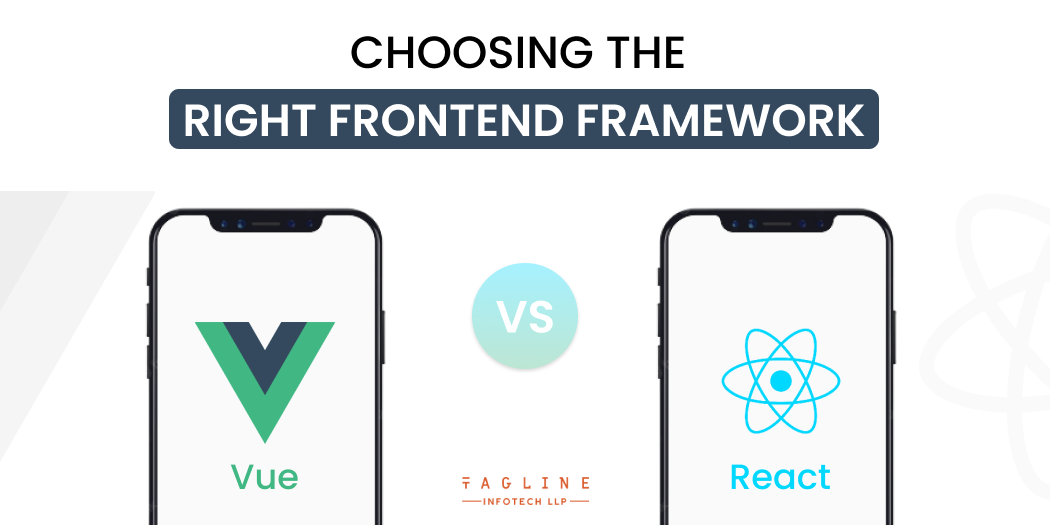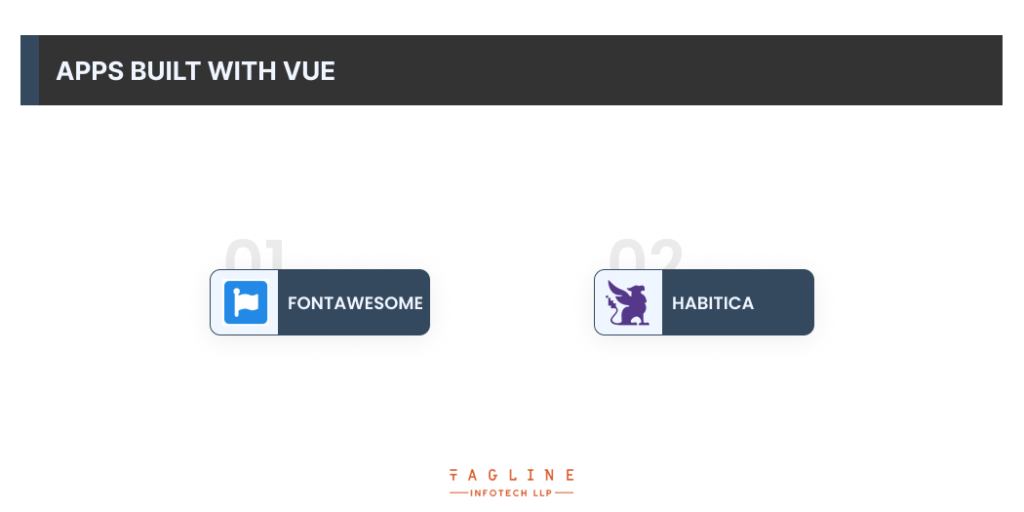How ChatGPT and RPA are Transforming Automation’s Future
May 17, 2024
Home >> Vue.Js >> Choosing the Right Frontend Framework: Vue vs React

Introduction
Two of the most well-liked JS frameworks for front-end development are Vue vs React.
Both are simple to use, have active community support, and have a wide ecosystem, enabling developers to create web applications with scalable, interactive, and attractive user interfaces.
The application you’re developing, the scale and complexity of your project, and the knowledge and expertise of your front-end engineers will all play a role in determining whether to choose React vs Vue for your web development project, even if both frameworks may achieve comparable outcomes.
The JavaScript framework called Vue, developed by Evan You, aims to make front-end programming approachable and pleasant for programmers of all experience levels.
Thanks to its progressive character, it may be gradually integrated into projects, making it adaptable to new and current applications.
Data binding and the building of dynamic user interfaces are made simple and obvious by Vue’s syntax, which combines HTML content with directives and expressions particular to the framework.
Components may define and change their state with the help of Vue’s reactive data model, which results in automatic user interface updates.
Facts about Vue
React, developed by Facebook (Meta), is a popular JavaScript package that uses a virtual DOM strategy and a component-based design.
The core of the React philosophy is the composition of reusable components to create user interfaces.
React’s use of a virtual DOM (Document Object Model) is one of its distinctive characteristics. React makes a virtual copy of the DOM in memory instead of altering it in the web browser.
React can quickly ascertain what needs to be changed by comparing this virtual representation to the actual DOM. Performance is enhanced since it only alters the real DOM as necessary.
Facts about React
A virtual DOM, an independent object model not dependent on a browser, is used by React. HTML pages are automatically rendered by the framework.
Vue employs virtual DOM, and its essential principles are similar to those of React. This explains why there aren’t much variations in terms of speed and performance quality between Vue and React.
Vue, however, is more rapid when it comes to building and updating components. In React, you must re-optimize a component every time you change it.
Then, a distinct command (pureComponent and shouldComponentUpdate) should be used to identify each component. As a project expands, managing hundreds of components gets difficult and may lead to tech debt.
At least 1,600 000 websites utilise React js. According to StackOverflow, most software engineers prefer it as their front-end development framework.
It is now the most popular JS framework available.
Currently, around 800,000 websites globally utilise Vue.js. In a study of JS frameworks conducted by Stack Overflow, it is ranked second in popularity, just behind React JS.
Vue and React are the most popular JavaScript frameworks for building web applications. Here is a thorough comparison of React vs Vue based on the following factors:
How smooth it’s miles to regulate and regulate it to satisfy the wishes of your challenge, both thru its center components or via 1/3-party add-ons, which generally do now not have the identical quantity of documentation and manual.
How smooth it is to begin a venture and write code. This is critical as it impacts how rapid we can launch a undertaking and the manner short new developers can start producing.
This is critical since it affects how well an app runs on a user’s device.
It’s an important factor since it may differ between a delightful app experience (that users will return to) and a frustrating one (that they will likely abandon).
This will essentially influence how soon developers may obtain assistance if they become stuck and how simple it is to locate answers to common problems.
Ready to Take Your Front-End Development to the Next Level?
Hire developers from us to building captivating user interfaces and seamless user experiences Web Applications.
React, which is essentially a UI framework, is renowned for its versatility. It enables developers to create code that is functional or component-based. This implies that programmers can choose the coding approach with which they are most comfortable in order to produce successful apps.
Vue also offers much flexibility because we can begin by using just the fundamental library and add to it as our project grows. Vue supports the component-based and functional programming paradigms, including JSX, along with a sizable number of frameworks and tools.
Through third-party plugins, React additionally provides routing and state management to regulate navigational flow and manage application data.
Furthermore, one of its pillars, JSX, makes writing JavaScript syntax comparable to HTML straightforward, allowing developers to create and combine components with ease.
Vue provides native routing and state management modules to simplify navigation flow and application data management. Programmers may also create reusable and maintainable components using Vue’s template syntax.
React is simple to set up and use for development, and it comes with a Microsoft-developed Visual Studio Code plugin for development and debugging.
The official CLI, named Create React App, enables us to rapidly set up the fundamental scaffolding so we can begin writing.
Vue is extremely simple to set up and use for development. It also includes its own Visual Studio Code extension, a more robust and feature-rich CLI for building SPAs quickly than React’s, and a plugin system.
There is also Vue Devtools, an official browser devtools addon for debugging Vue apps.
React is quick because it is made to render user interfaces, which is one thing, and do it effectively. React should run admirably without any more effort, and there are detailed instructions for further improving performance.
Although React has respectable performance, Vue is significantly quicker. Due to its virtual DOM, which ensures that only the relevant components are re-rendered when data changes, it is designed to be performant and efficient.
Performance improvements can be further increased because Vue natively supports server-side rendering.
Also Read : What is Vue.js? Why Vue.js is the Future of Front-End Development

Here are some instances of well-known websites adopting React applications and their justifications for doing so:

Here are some examples of apps that were built using Vue:
The mobile applications for Android and iOS, which use the Vue frameworks, provide a unique method to arrange your daily schedule.
Popular front-end frameworks Vue and React both provide user-friendly interfaces and wide-ranging ecosystems. Evan You is the leader of Vue, which supports reactive data management and easy syntax through progressive integration.
The Facebook (Meta) product React thrives on reusable components and a virtual DOM approach. While React’s performance and versatility enthral consumers, Vue shines because to its speedier component updates.
Giants like Facebook, Netflix, and Airbnb have adopted React, which has enormous popularity, while Vue also enjoys great support. For agility, pick Vue, and for performance, pick React.
The decision depends on the demands of the project and team comfort level. Both enable developers to create excellent user interfaces.
The pleasant way to decide which tool to use in a given circumstance is to try several alternatives. By utilizing each of them even as operating on minor initiatives, choose the framework that high-quality suits you.
The traits of your task, consisting of its agility and performance optimization, will decide whether Vue or React should be used. Connect with a React development company that can deliver customized solutions according to your needs.
Before you move to your ride, investigate their specific traits, interact with their humans, and suit the mission’s targets with the framework’s abilities.
Vue and React give developers the gear they need to create consumer-focused, captivating, and present-day on-line apps.
Small initiatives paintings nicely with Vue and React. Vue is a extraordinary choice for fast improvement because of its simplicity and simplicity of connection. Smaller programs can benefit from the element-based totally structure of React.
Strong documentation and vibrant communities are capabilities of both Vue and React. While Vue's network is renowned for its helpfulness and approachability, React's extra consumer base may additionally result in greater large sources.

Digital Valley, 423, Apple Square, beside Lajamni Chowk, Mota Varachha, Surat, Gujarat 394101
+91 9913 808 2851133 Sampley Ln Leander, Texas, 78641
52 Godalming Avenue, wallington, London - SM6 8NW